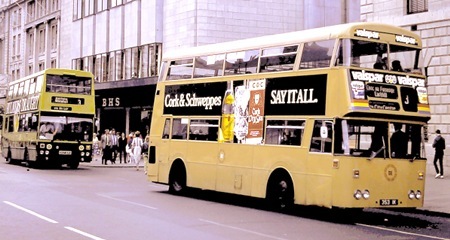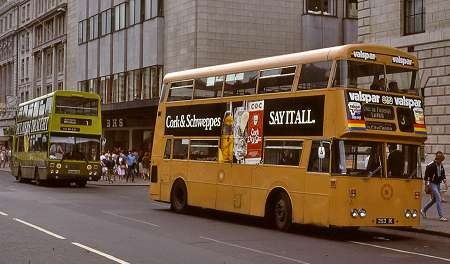CIE (Coras Iompair Eireann)
1970
Leyland Atlantean PDR1A/1
CIE/MSL H43/31D
Ireland’s national transport authority – CIE – came late to the rear-engine bus scene. Although they had been wooed by Leyland from an early date (and even trying a Guy Wulfrunian), the first buses from an initial order for 341 Atlantean PDR1/1′s did not enter service until late 1966, known as the ‘D’ type. Subsequent batches brought the total number of PDR1’s to an amazing 602 by 1974, followed by a further 238 AN68/1’s by 1977.
To reduce costs and to give work to CIE staff, all the chassis came in knocked-down form for local assembly and, because CIE were unimpressed with the box-like shape of early Atlanteans, they were fitted with these unusual CIE/Metal Sections bodies. The first 218 were fitted with a front-entrance 78-seat body but the remainder had 74-seat dual-entrance bodies in the certain expectation of one-person operation which, because of local union objections, never materialised until 1986, by which time many of the early examples had been withdrawn.
Leyland’s notoriously unreliable vehicle performance, spares availability and after-sales service during the 1970s finally exhausted CIE’s patience, and many Atlanteans (and Leopards) had to be re-engined by DAF and GM. In a desperate attempt to break away from their reliance on British supplies, and to create a totally home-grown bus industry, CIE came up with the unique German-designed, GM-engined Bombardier buses in the early 1980s which were built in Shannon – but that’s another story.
This photo of D353 shows one of the 1970 batch of PDR1A/1’s on Dublin’s O’Connell Street in 1984, two years before CIE decided to split its bus and train divisions into separate companies (Irish Bus, Dublin Bus and Irish Rail). It is seen wearing the thankfully short-lived tan livery which replaced the smarter blue and cream scheme, before giving way to a smart two-tone green as seen on the Bombardier in the photograph.
Photograph and Copy contributed by Paul Haywood
26/10/12 – 07:37
A cast iron contender for the Ugly Bus page.
Phil Blinkhorn
26/10/12 – 10:11
Exactly my reaction, too, Phil! Looks like CIE’s experience with Atlanteans mirrored M&D’s experience, also.
Roy Burke
26/10/12 – 10:12
Yes, Phil, but how high would it be in the ratings, bearing in mind what ugly ducklings are on that page already?
Too new for this site, but I have a view of one of the tan-liveried ones (Van Hool/McArdle body) on parade in Southampton for “Committee Inspection”, alongside the usual East Lancs product in July 1975.
I was under the impression that CIE had a green and cream livery – the one with the flying snail logo – before the tan, and then they went to the blue and cream one which I’ve seen at Duxford a couple of times, before going to two-tone green. Liverpool and Birmingham respectively spring to mind, but whose livery inspired the tan? More important, how far adrift from reality is my memory?
Pete Davies
26/10/12 – 10:20
Amazing Phil – I read that bit about CIE/Metal Sections bodies, but I didn’t realise the metal sections were cast iron!
Stephen Ford
26/10/12 – 14:26
Pete,
The double decker liveries were: pre war and into the late 1940s mid green with three white bands
Late 1940s to 1961 the green was much darker and the bands were painted light green.
From the 1961 the colour scheme was gradually changed across the fleet to a blue and cream one reminiscent of Birmingham’s, including the sandy coloured roof, though this feature was deleted on repainting. The first Atlanteans appeared in that scheme before the adoption of the scheme shown above, which was not applied to front engined double deckers.
Phil Blinkhorn
26/10/12 – 17:27
Baffling, isn’t how in Dublin the buses were ever Black and Tan? This body had the bookends look with sloping front and back- a precursor of the Olympic “Routemaster”? Works no better…. but then a sort of nod to Liverpool with the peak. The side window frames slope one way, and the upper front deck the other. The strong (that’s the answer) green now looks good, as did the original green- with those Gaelic bus stop signs.The old CIE logo was (also?) a circle of segments (if you follow). If you want to see lots of buses (no wonder the fleet is huge) go to Dublin: the only way to get around is the bus.
Off topic but still Leyland: what were those two Titans tantalisingly in the background in the Antiques Roadshow last Sunday? Beautiful greeny/goldy livery on one, despite what I just said….
Joe
27/10/12 – 06:23
Thanks, Phil.
Pete Davies
27/10/12 – 06:25
The Titans were a Massey bodied PD2 late of Birkenhead in blue and cream and the other one with an MCW body once belonged to Wallasey.
Phil Blinkhorn
27/10/12 – 06:27
Sorry, Joe, I cant give you a definite answer as I didn’t see the programme. However, it came from Port Sunlight so the most likely answer is that the blue one would have been either one of the two preserved Leyland’s from Birkenhead Corporation fleet. Both are Massey bodied, BG 9225 is a 1946 Titan PD1/A and FBG 910 is a 1958 PD2/40. I don’t know where the green/gold vehicle would be from, unless of course it was both of them and one had been given a repaint for some special event and will be returned to its correct livery at a later date
Ronnie Hoye
27/10/12 – 09:36
Joe, you’re right about the strange choice of liveries used by CIE over the years. The original green was logical enough considering their history, but to go black and tan for the buses (and – don’t forget – the railways) always seemed perverse considering the baggage that those colours carried. You say the only way to get around Dublin is by bus, but don’t forget their two superb tram lines and the extensive Dublin Area Rapid Transit railway which have transformed the city’s transport network in recent years.
Paul Haywood
03/01/13 – 13:02
As an Irish person (and transport photographer) I feel I have to correct comments made here. We never had a black and tan bus livery anywhere in Ireland. The buttermilk tan livery, as shown in the picture at the top of this page, replaced a livery known as monstral blue and cream, which looked very similar to black and white, the blue was very dark and the cream was very light! Then of course when C.I.E was spilt in 1987 the Atlanteans took on red and white Bus Eireann livery or Dublin Bus Green, depending on which of the 2 companies they were working for.
As I can’t post links here check out my flickr page, under the name irishmanufan, in the collections fotopic rescue and rallies and preserved buses to see pictures of Irish Atleanteans in monstral blue and cream, butter milk tan and Dublin Bus Green. 2 are standard D’s (PDR1) and one is an AN68.
Linda
Just include the url if you want to post a link. Irishmanufan
03/01/13 – 15:29
Fair point, Linda, but “black and tan” has been a description long used for this CIE livery (and particularly for the railways of this period) by many enthusiasts both British and Irish, rightly or wrongly. As you will know better than me, the shade of “tan” on the bus illustrated here varied considerably between batches and overhauls and some were distinctly darker (and more “tan”) than shown here. The point of the postings is to say “good riddance” to this livery, regardless of how it’s described, when we consider the more attractive liveries that were used before and since this period.
Paul Haywood
03/01/13 – 15:30
The blue CIE livery was in some ways a copy of the Birmingham livery and was applied in similar manner. No operator would dare to run buses in the Republic in black and tan!
Chris Hough
04/01/13 – 14:07
I’m still baffled. If you were going to use “buttermilk tan”, it is hardly tactful to team it with “Guinness black” wheels. The original West Yorkshire Metro livery was, if I recall, Buttermilk (lighter than this) with a gentle (emerald) green- and red wheels? That would have done the trick.
Fortunately, caramac clearly didn’t last long: could have been worse: pink & blue with fuzzy bits.
Joe
08/02/13 – 06:40
This livery was NEVER described as Black & Tan on C.I.E buses…The correct livery was Middle Buff made by British Paints Ltd and its reference no. is BS 350…I know this as Liam Dunne, no less told me when I did stand work with him at the Commercial Motor Show in Earls Court in 1974 and later at the NEC in 1978..Liam was C.M.E of C.I.E Road Services and later M.D of Van Hool McArdle in Spa Rd Dublin.. Hope this helps..
David O’Connor
14/04/13 – 08:02
Well I never heard the original D class Atlanteans described as ugly before. They were a significant advance on other bodies back in 1966.
tarabuses
 Vehicle reminder shot for this posting
Vehicle reminder shot for this posting
18/10/13 – 18:35

I’ve just bought a new scanner and got a far better scan of the CIE Dublin Atlantean. This shows a more accurate “tan” which may or may not settle the “black and tan” controversy.
Paul Haywood

Leave a Reply